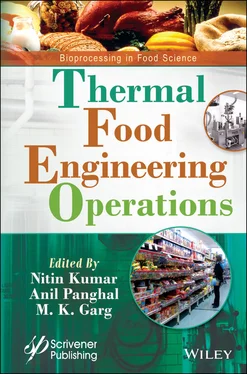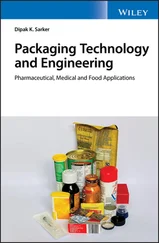NITIN KUMAR - Thermal Food Engineering Operations
Здесь есть возможность читать онлайн «NITIN KUMAR - Thermal Food Engineering Operations» — ознакомительный отрывок электронной книги совершенно бесплатно, а после прочтения отрывка купить полную версию. В некоторых случаях можно слушать аудио, скачать через торрент в формате fb2 и присутствует краткое содержание. Жанр: unrecognised, на английском языке. Описание произведения, (предисловие) а так же отзывы посетителей доступны на портале библиотеки ЛибКат.
- Название:Thermal Food Engineering Operations
- Автор:
- Жанр:
- Год:неизвестен
- ISBN:нет данных
- Рейтинг книги:5 / 5. Голосов: 1
-
Избранное:Добавить в избранное
- Отзывы:
-
Ваша оценка:
- 100
- 1
- 2
- 3
- 4
- 5
Thermal Food Engineering Operations: краткое содержание, описание и аннотация
Предлагаем к чтению аннотацию, описание, краткое содержание или предисловие (зависит от того, что написал сам автор книги «Thermal Food Engineering Operations»). Если вы не нашли необходимую информацию о книге — напишите в комментариях, мы постараемся отыскать её.
Presenting cutting-edge information on new and emerging food engineering processes,
, the first volume in the new series, “Bioprocessing in Food Science,” is an essential reference on the modeling, quality, safety, and technologies associated with food processing operations today.
This outstanding new volume:
Audience:
Thermal Food Engineering Operations — читать онлайн ознакомительный отрывок
Ниже представлен текст книги, разбитый по страницам. Система сохранения места последней прочитанной страницы, позволяет с удобством читать онлайн бесплатно книгу «Thermal Food Engineering Operations», без необходимости каждый раз заново искать на чём Вы остановились. Поставьте закладку, и сможете в любой момент перейти на страницу, на которой закончили чтение.
Интервал:
Закладка:
2.2 Innovate Thermal Techniques for Food Reservation
Pasteurization and sterilization are the leading and finest processing techniques in the industrial sector. These techniques stop the rapid multiplication of spoilage and microbial organism present in the food and eliminate it by the application of heat in an acidic medium [11]. Temperature also plays a vital role in the thermal processing method. The higher the temperature of the food product while entering the process, the more speedily it helps in killing the microbes present in the food [12].
Though high-temperature traditional processing confirms the microbial safety of the food products by reducing it into 3 log cycle as per the 21 Code of Federal Regulation Part 114 [13], the limitations which arise during the application in terms of organoleptic and nutritional properties compels to limit the usage of these traditional techniques. These limitations also extend to non-uniform heating, degradation of the final quality of product, and low heat transfer. But currently, potential heating systems have come up as an alternative to replace the exciting conventional system, some of which are microwave heating, radiofrequency heating, ohmic heating, infrared heating, and instant control pressure drop technology (DIC) [14]. These alternative techniques of heat processing provide the advantages of volumetric and uniform heating while maintaining the quality of the final product and reducing the surplus treatment time by heating directly the food sample [15].
Few bacteria display an advanced heat resistance, subsequently being exposed to temperatures which only stress them [16, 17]. The growth medium of the organism, the growth temperature, and the phase of growth are significant issues concerning their aptitude to withstand heat. It is a very common phenomenon that the bacteria surviving different stress conditions have quite a high tolerance level to the different environmental situations and heat [18]. Inactivation does not mean that all the microbial cells are destroyed but it depends upon the number of cells present in the food sample. The maximum number of cells indicates the increased consumption of time for inactivation of the microorganisms in the food sample. The design of the thermal inactivation process for a given food depends on (i) the heat resistance of the most resistant microorganism (in the product); (ii) the food products dimensions; and (iii) thus the rate of heat penetration within the food matrix [19].
Therefore, this section brings, in particular, all the possible novel heat processing technologies for decontamination of spoilage and pathogenic microorganism present in the food. The table mentioned below provides a summary of the studies done on the microbial techniques and outcome which were achieved for the different food items and their change in properties after the treatment.
2.3 Inactivation Mechanism of Targeted Microorganism
The effective application of innovative technology for food preservation depends on the development in the field of inactivation mechanisms. A requisite acquaintance with the physiological behavior of microorganisms in the direction of decontamination factors is indispensable for the advancement of secure food products [20]. It is vital to consider and understand the crucial environmental factor for identifying the resistance in the food product. This will support easy construction of the mathematical model and interpret the kinetics which is done based on the parameters with an effective prediction of the decontamination in a wider range [21]. Therefore, designing a process becomes easier by gathering information on different preservation agents. The efficiency of any method utilized depends upon product type, the process used, and targeted microorganisms [22]. Inactivation mechanisms depend on the technique utilized for the above action and are also influenced by the structure and number of the microbial cell. Environmental stress kills or injures cells of the microorganism but in some cases, it might cause sublethal injury or also might cause total lethal cell death [23].
Destruction of the cell wall is the main factor which leads to the inactivation of microorganism and it also depends upon the cell morphology and shape of the cell. Destruction of the cell wall can be achieved by either chemical process by modifying the wall leading to leakage of the cellular content or by altering the constituents chemically. As already known, heat is the major factor that causes destruction of the membrane as well as protein denaturation but what type of heat, it is tough to state [24].
Application of significant high pressure with heat can lead to disorientation of the cellular structure of the microorganism and also lead to protein denaturation, whereas this is hardly seen in the bacterial spore because of their morphology. As visually seen nevertheless, that hydrostatic pressure treatment can induce for growth of bacterial spores and a combination of swift decompression pressure and elevated temperature leads to the destruction of the spores which re-germinated [25].
Tolerance of microbial stress is affected both by intrinsic and extrinsic factors as resistance during stationary growth and during exponential growth varies because of varied stress sigma factors [26, 27]. With the intention of endurance, micro-organisms incline to produce biofilms, the utmost prevailing microbial defensive structure. Bacteria produce carbohydrate matrices and might consequently condense the efficiency of approaches for inactivation [28].
2.3.1 Action Approach and Inactivation Targets
Damage to cell structure or any type of physiological change can indicate the death of the cell. So, during the process of cell structure disruption, cell envelopes break, change the anatomy of DNA, alters the ribosome, and disintegrates the protein [29]. Whereas during the physiological change fluctuation of permeability in addition to the loss of enzyme functionality leads to death of the cell. So, during the inactivation process the above changes can occur solely or combinedly, and therefore, identifying the particular event becomes problematic for the researchers while coming across events in this area. Therefore, keeping in mind, the following situation, this can be possible to have multiple inactivation actions that combine to cause the death of the cell. It is likewise probable that the important aim solitary affected when a secondary structure is beforehand injured. For example, due to heat, there is nutrient loss, ions loss, the disintegration of DNA, denaturation of crucial proteins and enzymes [30]. Therefore, exactly capturing the real event of death of the cells becomes difficult as the structure of the cell is also affected by higher temperature. The only possible way to find out the exact reason is by examining the relation between inactivation degree and the modification dress of the targeted microorganism concerning various environmental conditions.
2.4 Environmental Stress Adaption
The cell contains some extracellular protein, which warns or senses the probability of danger when there is any environmental stress for instance heat [31]. These processes comprise fluctuations of events of protein and gene expression with the persistence of averting and/or lessening injury to cells. As already discussed, resistance is higher in the stationary phase of growth rather than the exponential one because of the sigma factor [32]. If a bacterium survives, it can exist in a VBNC state. This denotes a state in which the cells cannot be detected by standard culture on enriched agar media, although remaining viable and capable of resuscitation under favorable conditions. VBNC was mainly observed among Gram-negative bacteria and has been proposed as a strategy for survival in natural environments [33]. More than 60 bacterial species are described as being able to enter into a VBNC state, among them Gram-positive (e.g., L. monocytogenes, Enterococcus, Micrococcus luteus ) and Gram-negative (e.g., E. coli, Vibrio cholerae, Vibrio vulnificus, Legionella pneumophila, Campylobacter jejuni, Salmonella enterica, Pseudomonas aeruginosa, Helicobacter pylorii ) bacteria can be found [34].
Читать дальшеИнтервал:
Закладка:
Похожие книги на «Thermal Food Engineering Operations»
Представляем Вашему вниманию похожие книги на «Thermal Food Engineering Operations» списком для выбора. Мы отобрали схожую по названию и смыслу литературу в надежде предоставить читателям больше вариантов отыскать новые, интересные, ещё непрочитанные произведения.
Обсуждение, отзывы о книге «Thermal Food Engineering Operations» и просто собственные мнения читателей. Оставьте ваши комментарии, напишите, что Вы думаете о произведении, его смысле или главных героях. Укажите что конкретно понравилось, а что нет, и почему Вы так считаете.












